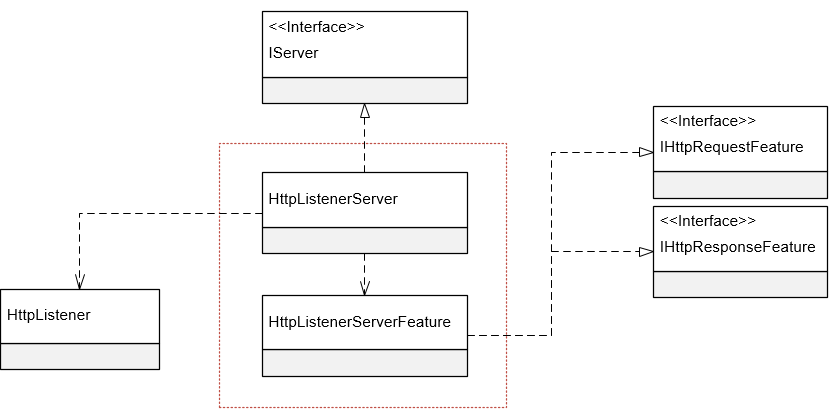我們在上面對ASP.NET Core預設提供的具有跨平臺能力的KestrelServer進行了詳細介紹(《聊聊ASP.NET Core預設提供的這個跨平臺的伺服器——KestrelServer》),為了讓讀者朋友們對管道中的Server具有更加深刻的認識,接下來我們採用實例演示的形式創建一個自定義的 ...
我們在上面對ASP.NET Core預設提供的具有跨平臺能力的KestrelServer進行了詳細介紹(《聊聊ASP.NET Core預設提供的這個跨平臺的伺服器——KestrelServer》),為了讓讀者朋友們對管道中的Server具有更加深刻的認識,接下來我們採用實例演示的形式創建一個自定義的Server。這個自定義的Server直接利用HttpListener來完成針對請求的監聽、接收和響應,我們將其命名為HttpListenerServer。在正式介紹HttpListenerServer的設計和實現之前,我們先來顯示一下如何將它應用到 一個具體的Web應用中。
一、HttpListenerServer的使用
我們依然採用最簡單的Hello World應用來演示針對HttpListenerServer的應用,所以我們在Startup類的Configure方法中編寫如下的程式直接響應一個“Hello World”字元串。
1: public class Startup
2: {
3: public void Configure(IApplicationBuilder app)
4: {
5: app.Run(context => context.Response.WriteAsync("Hello World!"));
6: }
7: }
在作為程式入口的Main方法中,我們直接創建一個WebHostBuilder對象並調用擴展方法UseHttpListener完成針對自定義HttpListenerServer的註冊。我們接下來調用UseStartup方法註冊上面定義的這個啟動類型,然後調用Build方法創建一個WebHost對象,最後調用Run方法運行這個作為宿主的WebHost。
1: public class Program
2: {
3: public static void Main()
4: {
5: new WebHostBuilder()
6: .UseHttpListener()
7: .UseStartup<Startup>()
8: .Build()
9: .Run();
10: }
11: }
12:
13: public static class WebHostBuilderExtensions
14: {
15: public static IWebHostBuilder UseHttpListener(this IWebHostBuilder builder)
16: {
17: builder.ConfigureServices(services => services.AddSingleton<IServer, HttpListenerServer>());
18: return builder;
19: }
20: }
我們自定義的擴展方法UseHttpListener的邏輯很簡單,它只是調用WebHostBuilder的ConfigureServices方法將我們自定義的HttpListenerServer類型以單例模式註冊到指定的ServiceCollection上而已。我們直接運行這個程式並利用瀏覽器訪問預設的監聽地址(http://localhost:5000),服務端響應的“Hello World”字元串會按照如下圖所示的形式顯示在瀏覽器上。

二、總體設計
接下來我們來介紹一下HttpListenerServer的大體涉及。除了HttpListenerServer這個實現了IServer的自定義Server類型之外,我們只定義了一個名為HttpListenerServerFeature的特性類型,下圖所示的UML基本上體現了HttpListenerServer的總體設計。

三、HttpListenerServerFeature
如果我們利用HttpListener來監聽請求,它會為接收到的每次請求創建一個屬於自己的上下文,具體來說這是一個類型為HttpListenerContext對象。我們可以利用這個HttpListenerContext對象獲取所有與請求相關的信息,針對請求的任何響應也都是利用它完成的。上面這個HttpListenerServerFeature實際上就是對這個作為原始上下文的HttpListenerContext對象的封裝,或者說它是管道使用的DefaultHttpContext與這個原始上下文之間溝通的中介。
如下所示的代碼片段展示了HttpListenerServerFeature類型的完整定義。簡單起見,我們並沒有實現上面提到過的所有特性介面,而只是選擇性地實現了IHttpRequestFeature和IHttpResponseFeature這兩個最為核心的特性介面。它的構造函數除了具有一個類型為HttpListenerContext的參數之外,還具有一個字元串的參數pathBase用來指定請求URL的基地址(對應IHttpRequestFeature的PathBase屬性),我們利用它來計算請求URL的相對地址(對應IHttpRequestFeature的Path屬性)。IHttpRequestFeature和IHttpResponseFeature中定義的屬性都可以直接利用HttpListenerContext對應的成員來實現,這方面並沒有什麼特別之處。
1: public class HttpListenerServerFeature : IHttpRequestFeature, IHttpResponseFeature
2: {
3: private readonly HttpListenerContext httpListenerContext;
4: private string queryString;
5: private IHeaderDictionary requestHeaders;
6: private IHeaderDictionary responseHeaders;
7: private string protocol;
8: private readonly string pathBase;
9:
10: public HttpListenerServerFeature(HttpListenerContext httpListenerContext, string pathBase)
11: {
12: this.httpListenerContext = httpListenerContext;
13: this.pathBase = pathBase;
14: }
15:
16: #region IHttpRequestFeature
17:
18: Stream IHttpRequestFeature.Body
19: {
20: get { return httpListenerContext.Request.InputStream; }
21: set { throw new NotImplementedException(); }
22: }
23:
24: IHeaderDictionary IHttpRequestFeature.Headers
25: {
26: get { return requestHeaders
27: ?? (requestHeaders = GetHttpHeaders(httpListenerContext.Request.Headers)); }
28: set { throw new NotImplementedException(); }
29: }
30:
31: string IHttpRequestFeature.Method
32: {
33: get { return httpListenerContext.Request.HttpMethod; }
34: set { throw new NotImplementedException(); }
35: }
36:
37: string IHttpRequestFeature.Path
38: {
39: get { return httpListenerContext.Request.RawUrl.Substring(pathBase.Length);}
40: set { throw new NotImplementedException(); }
41: }
42:
43: string IHttpRequestFeature.PathBase
44: {
45: get { return pathBase; }
46: set { throw new NotImplementedException(); }
47: }
48:
49: string IHttpRequestFeature.Protocol
50: {
51: get{ return protocol ?? (protocol = this.GetProtocol());}
52: set { throw new NotImplementedException(); }
53: }
54:
55: string IHttpRequestFeature.QueryString
56: {
57: Get { return queryString ?? (queryString = this.ResolveQueryString());}
58: set { throw new NotImplementedException(); }
59: }
60:
61: string IHttpRequestFeature.Scheme
62: {
63: get { return httpListenerContext.Request.IsWebSocketRequest ? "https" : "http"; }
64: set { throw new NotImplementedException(); }
65: }
66: #endregion
67:
68: #region IHttpResponseFeature
69: Stream IHttpResponseFeature.Body
70: {
71: get { return httpListenerContext.Response.OutputStream; }
72: set { throw new NotImplementedException(); }
73: }
74:
75: string IHttpResponseFeature.ReasonPhrase
76: {
77: get { return httpListenerContext.Response.StatusDescription; }
78: set { httpListenerContext.Response.StatusDescription = value; }
79: }
80:
81: bool IHttpResponseFeature.HasStarted
82: {
83: get { return httpListenerContext.Response.SendChunked; }
84: }
85:
86: IHeaderDictionary IHttpResponseFeature.Headers
87: {
88: get { return responseHeaders
89: ?? (responseHeaders = GetHttpHeaders(httpListenerContext.Response.Headers)); }
90: set { throw new NotImplementedException(); }
91: }
92: int IHttpResponseFeature.StatusCode
93: {
94: get { return httpListenerContext.Response.StatusCode; }
95: set { httpListenerContext.Response.StatusCode = value; }
96: }
97:
98: void IHttpResponseFeature.OnCompleted(Func<object, Task> callback, object state)
99: {
100: throw new NotImplementedException();
101: }
102:
103: void IHttpResponseFeature.OnStarting(Func<object, Task> callback, object state)
104: {
105: throw new NotImplementedException();
106: }
107: #endregion
108:
109: private string ResolveQueryString()
110: {
111: string queryString = "";
112: var collection = httpListenerContext.Request.QueryString;
113: for (int i = 0; i < collection.Count; i++)
114: {
115: queryString += $"{collection.GetKey(i)}={collection.Get(i)}&";
116: }
117: return queryString.TrimEnd('&');
118: }
119:
120: private IHeaderDictionary GetHttpHeaders(NameValueCollection headers)
121: {
122: HeaderDictionary dictionary = new HeaderDictionary();
123: foreach (string name in headers.Keys)
124: {
125: dictionary[name] = new StringValues(headers.GetValues(name));
126: }
127: return dictionary;
128: }
129:
130: private string GetProtocol()
131: {
132: HttpListenerRequest request = httpListenerContext.Request;
133: Version version = request.ProtocolVersion;
134: return string.Format("{0}/{1}.{2}", request.IsWebSocketRequest ? "HTTPS" : "HTTP", version.Major, version.Minor);
135: }
136: }
四、HttpListenerServer
接下來我們來看看HttpListenerServer的定義。如下麵的代碼片段所示,用來監聽請求的HttpListener在構造函數中被創建,與此同時,我們會創建一個用於獲取監聽地址的ServerAddressesFeature對象並將其添加到屬於自己的特性列表中。當HttpListenerServer隨著Start方法的調用而被啟動後,它將這個ServerAddressesFeature對象提取出來,然後利用它得到所有的地址並添加到HttpListener的Prefixes屬性表示的監聽地址列表中。接下來,HttpListener的Start方法被調用,併在一個無限迴圈中開啟請求的監聽與接收。
1: public class HttpListenerServer : IServer
2: {
3: private readonly HttpListener listener;
4:
5: public IFeatureCollection Features { get; } = new FeatureCollection();
6:
7: public HttpListenerServer()
8: {
9: listener = new HttpListener();
10: this.Features.Set<IServerAddressesFeature>(new ServerAddressesFeature());
11: }
12:
13: public void Dispose()
14: {
15: listener.Stop();
16: }
17:
18: public void Start<TContext>(IHttpApplication<TContext> application)
19: {
20: foreach (string address in this.Features.Get<IServerAddressesFeature>().Addresses)
21: {
22: listener.Prefixes.Add(address.TrimEnd('/') + "/");
23: }
24:
25: listener.Start();
26: while (true)
27: {
28: HttpListenerContext httpListenerContext = listener.GetContext();
29:
30: string listenUrl = this.Features.Get<IServerAddressesFeature>().Addresses.First(address => httpListenerContext.Request.Url.IsBaseOf(new Uri(address)));
31: string pathBase = new Uri(listenUrl).LocalPath.TrimEnd('/') ;
32: HttpListenerServerFeature feature = new HttpListenerServerFeature(httpListenerContext, pathBase);
33:
34: FeatureCollection features = new FeatureCollection();
35: features.Set<IHttpRequestFeature>(feature);
36: features.Set<IHttpResponseFeature>(feature);
37: TContext context = application.CreateContext(features);
38:
39: application.ProcessRequestAsync(context).ContinueWith(task =>
40: {
41: httpListenerContext.Response.Close();
42: application.DisposeContext(context, task.Exception);
43: });
44: }
45: }
46: }
HttpListener的GetContext方法以同步的方式監聽請求,並利用接收到的請求創建返回的HttpListenerContext對象。我們利用它解析出當前請求的基地址,併進一步創建出描述當前原始上下文的HttpListenerServerFeature。接下來我們將這個對象分別採用特性介面IHttpRequestFeature和IHttpResponseFeature添加到創建的FeatureCollection對象中。然後我們將這個FeatureCollection作為參數調用HttpApplication的CreateContext創建出上下文對象,並將其作為參數調用HttpApplication的ProcessContext方法讓註冊的中間件來逐個地對請求進行處理。
參考頁面:http://qingqingquege.cnblogs.com/p/5933752.html



